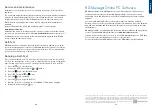
14
15
EN
GL
ISH
Transmitter Eco Mode
When using alkaline batteries, Eco mode can be selected to maximize run time. When
Eco mode is selected the transmitter automatically reduces its maximum power output as
battery levels run low. Eco mode is switched off by default. To Enable Eco Mode:
1. Press the
key to enter the menu.
2. Scroll to the BATT menu using the
or
arrows.
3. Press the
key to enter the BATT menu.
4. Select the ALK Battery type using the
or
arrows.
5. Press the
key to enter the ECO sub menu
6. Select ECO using the
or
arrows.
7. Press the
key three times to accept your selection and return to the main
operation screen.
SideStep
auto
™
The transmitter can be used to recommend a general-purpose locate frequency for the
intended locate task by measuring the impedance of the target cable or pipe.
SideStep
auto
helps to improve locate accuracy by determining the best signal. SideStep
auto
can also help to prolong battery life.
SideStep
auto
operates only in Direct Connection mode.
To enable SideStep
auto
: Connect the transmitter to the target utility, then:
1. Press the
key to enter the menu.
2. Scroll to the OPT F menu using the
or
keys.
3. Press the
key to enter the OPT F menu.
4. Scroll through using the
or
keys until START is displayed.
5. Press the
key to start SideStep
auto
and exit the OPTF Menu.
6. Press the
key to exit the menu.
NOTE: SideStep
auto
has to be enabled for each Direct Connection using the START
option. At any time the user may manually change the frequency using the
key.
Locating pipes
and cables
For more detailed descriptions of using the
locator and transmitter, and for detailed locate
techniques, refer to the RD7200 Operation
Manual.
The RD7200 locator is designed to operate
with the ‘blade’ of the locator perpendicular
to the path of the cable or pipe being located.
Locating with Active Frequencies
Active frequencies are applied to the target pipe or cable using the transmitter, and
provide the most effective way of tracing buried pipes or cables.
Generally speaking, it is better to use a low frequency on larger, low impedance utilities,
and move to a higher frequency on smaller, high impedance utilities.
The lowest power setting required to trace the target utility should always be used to
minimize the risk of false trails.
The transmitter can apply a signal using three different methods:
Direct connection
In direct connection, you connect the transmitter directly to the pipe or cable you wish to
survey using the red Direct Connect lead supplied. The black lead is generally connected
to earth using the supplied ground stake.
The transmitter will then apply a discrete signal to the line, which you can trace using the
locator. This method provides the best signal on an individual line and enables the use of
lower frequencies, which can be traced for longer distances.
WARNING! Direct connection to live conductors is POTENTIALLY LETHAL. Direct
connections to live conductors should be attempted by fully qualified personnel only
using the relevant products that allow connections to energized lines.
Induction
The transmitter is placed on the ground over or near the survey area. You select the
appropriate frequency. The transmitter will then induce the signal indiscriminately to
any nearby metallic conductor. In induction mode, using higher frequencies is generally
recommended as they are induced more easily onto nearby conductors.
Transmitter Clamp
An optional signal clamp can be placed around an insulated live wire or pipe up to
8.5" / 215mm in diameter to transfer the transmitter signal to the utility. This method of
applying the transmitter signal is particularly useful on insulated live wires and removes
the need to disconnect the supply to the cable.
WARNING! Do not clamp around uninsulated live conductors.
WARNING! Before applying or removing the clamp around a power cable ensure
that the clamp is connected to the transmitter at all times.
Locating with Passive Frequencies
Passive frequency detection takes advantage of signals that are already present on
buried metallic conductors. The RD7200 supports up to three types of passive
frequencies: Power, Radio and CPS signals. You can detect these frequencies without
the aid of the transmitter.






























